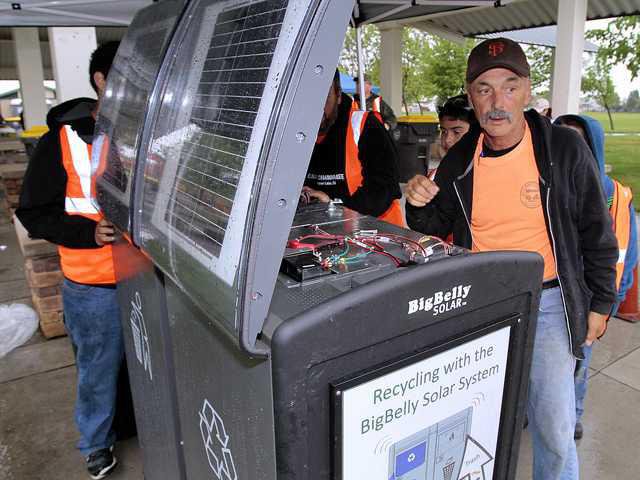BigBelly solar-powered trash bins with built-in compactors are multiplying in Manteca and city trash collection costs are shrinking.
Adam Pintor of Boy Scout Troop 432 coordinated the installation of Big Belly trash and recycling bins at Woodward Park and the Manteca Unified School District complex on Louise Avenue Saturday as his Eagle Scout project. He worked with city Solid Waste Division to make the installations happen.
Pintor will monitor the cans for the next few moth months to make sure they are working properly and to log their use.
On Monday, city crews placed trash and recycling units at Northgate Community Park.
Two BigBelly solar-powered trash bins built-in compactors were placed at Big League Dreams and the quad at the Manteca Civic Center last year. There use has allowed the city to slash the number of trips a solid waste worker needs to make to empty the bins. It also helps make sure trash bins don’t overflow.
Unlike collecting residential Toters that are done with automated trucks, park trash bins require a driver to go off route, park his vehicle, walk to the trash container, take it to the truck and dump it and then return it to its location, before going back to their truck.
The BigBelly trash and recyclable collection bins have reduced the need for pickups by at least half. It also allows recyclables to be separated from regular trash.
Once the items inside the trash bins reach a certain level, the contents are compacted. They hold five times the amount of a bin of similar size. When the bins are full, a computer sends a message to the BigBelly cloud that then notifies the Manteca Solid Waste Division so a pickup can be scheduled.
The bins are solar powered and do not require electricity. The bins constantly recharge an internal battery during daylight hours. Bins are able to function for more than 72 hours without direct sunlight.
The compaction feature allows them to hold 150 gallons of trash or recyclables instead of the 30-gallon capacity of a non-smart bin.
A BigBelly hopper design feature keeps waste contained in the bin while deterring pest access and preventing water overflow and wind-blown litter. It also assures that no one can get near the compaction mechanism when it is working.
Manteca purchased the BigBelly bins with state grant money from recycling receipts that must be spent on efforts to promote recycling.
The city had planned to place additional BigBelly bins at locations such as Lincoln Park and Library Park that get high use and subsequently generate a lot of trash.
BigBelly, however, has stopped selling the bins and has gone to 100 percent le4asing.
Rexie Strange of Solid Waste said the switch by BigBelly is requiring the city to reassess its strategy.
“We had planned on buying more since they are perfect for parks,” she said.
BigBelly has noted that many cities deploy the smart trash bins in various public venues such as downtowns, parks, and sports complexes in a bid to reduce costs as well as improve aesthetics.
Collection costs in some cities can run as high as $2,000 a year per downtown trash respectable due to frequent trash pickups. They also prevent litter and debris from being thrown around and in turn enhance the areas they serve — downtowns, sparks, and such — by creating a more favorable view for shoppers, visitors, and tourists.
Philadelphia, as an example, has deployed 1,000 Bigbelly stations throughout the central part of that city — including some tough neighborhoods — to reduce costs and keep streets clean.
The smart trash cans reduced Philadelphia’s downtown area collections from 17 to three a week. That city is averaging $1 million a year in operation, fuel, and truck costs.
BIGBELLY BINS
Scout oversees installation as Eagle project





